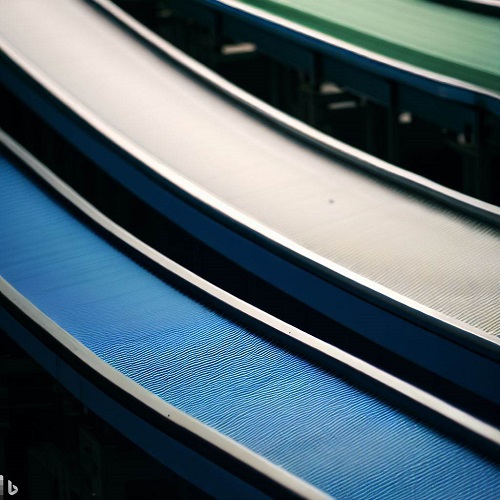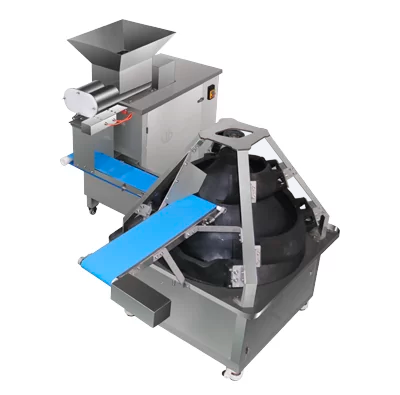
Baking and confectionery equipment like dough dividers and dough rounders encounters numerous intricate difficulties in transferring delicate ingredients, doughs, fermented doughs, shaped doughs and packages throughout the manufacturing process. To support all these applications, the market offers a wide range of bakery equipment belts like high strength belts, fabric reinforced belts and so on. What are the differences between them? What is the best bakery equipment belt for you? How to choose the right belt? How to clean and maintain them for hygiene and longer service life?
Understanding these questions and choosing the right one can be daunting. To provide a comprehensive guide on bakery equipment belts, this passage will discuss the materials of food-grade conveyor belts and provide tips on how to choose and maintain them.
What is Food-Grade Conveyor Belts Made of?
Equipment hygiene is crucial when processing and handling food products. It not only guarantees the safety of the items for consumption but also minimizes the possibility of cross-contamination. Therefore, selecting the appropriate materials for your conveyor belt system is paramount for effective processes. Here are some common materials for food handling conveyor belts and their significant characteristics.
Now in the conveyor belt industry, common materials that meet food grade requirements are PU (polyurethane), PE (polyethylene), PVC, SIR (silicone rubber), and PTFE (Teflon).
1. PU (Polyurethane)
PU is the abbreviation of polyurethane, which is the collective name of macromolecular compounds containing repeated polyurethane groups on the main chain.
This material is wear resistant, temperature resistant, harmless and odourless. non-polluting, non-toxic and tasteless. It is also resistant to the corrosion of many acid-bases (with PH value between 5 and 9) and organic solvents.
PU food grade conveyor belt uses polyurethane as the raw material and polyester fabric with lateral stability as the bearing framework, meeting FDA food grade standards and has been commonly used in the food processing industry worldwide.
2. PE (Polyalkene Hydrogen)
Polyalkylene hydrogen is a polymer made of alkene hydrogen polymerization. It has stable chemical properties and is resistant to the corrosion of a variety of chemicals at room temperature (except nitric acid, sulfuric acid). It is odorless and the applicable temperature is -70 ℃ ~ +150 ℃.
PE food grade conveyor belt uses polyolefin hydrogen as raw material and polyester staple fiber fabric with lateral stability as the bearing framework.
It meets FDA food grade standard and it is non-toxic when burning in high temperature. Conveyor belts made of PE is suitable for tobacco industry and food industry.
3. PVC (Polyvinyl Chloride)
PVC is a polymer of vinyl chloride, which has stable physical and chemical properties and is resistant to many kinds of acids and bases.
PVC food grade conveyor belt uses polyvinyl chloride as raw material and polyester fabric with lateral stability as bearing framework. It meets the sanitary requirements and is non-toxic, odorless, light, durable and not easy to deform.
4. SIR (Silicone Rubber)
Silicone rubber is a linear polymer elastomer made of dimethylsiloxane and other silicone monomers polymerized, with good heat resistance and anti-adhesive surface.
SIR food grade conveyor belt is non-toxic and odorless, with instant surface temperature resistance up to -100℃~+250℃. It is suitable for conveying sticky dough, confectionery, chocolate, etc.
5. PTFE (Teflon)
PTFE (trademark name Teflon) is resistant to acid, alkali, moisture, wear and high temperature (-70℃~+260℃).
PTFE food grade conveyor belt is woven from high quality glass fiber. Then it is fully soaked, impregnated and coated with Teflon by unique technology. This is how manufacturer produce high temperature resistant Teflon belts of various thicknesses.
How to Choose the Right Dough Divider Belt

Selecting the appropriate conveyor for your bakery and bakery equipment is crucial to enhance speed and workflow. Keeping items in motion at all times and avoiding downtime can make or break a production line. These machines and conveyor belts are not only a means of moving products, but also critical to optimizing hygiene and saving labor costs.
There are 7 factors to consider when selecting a conveyor belt, such as:
①Type and Characteristics of the Products
There is a wide range of bakery products and each product has its own recipe. The recipes of bread dough, pastry dough, pizza dough, cookie dough, cracker dough differ greatly in hydration, oil, and other ingredients. You need to choose the right conveyor belt or the dough pieces will stick to the belt.
②Temperature
Different parts of the food processing and transportation line have different temperature requirements. You should use ordinary food conveyor belts for the front parts of the production line, high-temperature food-grade network chains or Teflon conveyor belts for the high-temperature and dry processing, and Teflon or high-temperature resistant food conveyor belts for the drying and cooling parts.
③Color
White and blue conveyor belts are generally used for direct contact with food, to avoid belt color contamination to the food. Compared with white belts, blue belts are more commonly seen in the food processing and baking industry as they increase visibility and make identifying impurities or contaminants much easier. Green conveyor belts are generally used for food packages.
④Diameter of Rollers
There are different rollers to match conveyor belts of different thickness. When choosing or planning the layout of bakery production lines, it is supposed to consider the turn radius to extend the service of conveyor belts.
⑤Weight of Materials
Each food conveyor belt has a fixed number of layers to bear the weight of the materials. You should consider the capacity of the belt to avoid overloading.
⑥Oil Resistance
If you are processing foods containing oil like moon cakes and pastries, the conveyor belt must be oil resistant.
⑦Cost and Performance
The durability, maintenance and energy consumption of the conveyor belt should be considered.
3 General Guidelines for Choosing the Right Conveyor Belt
①For dough handling applications, you may want to use a smooth, non-stick, scraper-friendly and tensionless conveyor belt that can improve product release, reduce product waste and enhance food safety.
②For pan handling applications, you may want to use a modular plastic conveyor belt that can maintain product orientation, eliminate jams and optimize tight transfers.
③For spiral applications for freezing, cooling or proofing, you may want to use a low-tension spiral conveyor belt that can reduce product damage, increase throughput and save energy.
For packaging applications, you may want to use a flexible and durable conveyor belt that can handle various types of packaging materials and shapes.
Of course, these are just some examples of possible conveyor belts and equipment for bakery, dough divider, dough rounder and other bakery equipment. You may need to consult with the manufacturers or suppliers of the conveyor belts and equipment to find the best solution for your specific needs and requirements.
How to Prolong the Service Life of Conveyor Belts
1. Select the Appropriate Conveyor
Conveyor belts have different purposes and features, so you need to choose the right one for your specific application1. For instance, some belts are better for carrying heavy or rough materials, while others are better for carrying delicate or fragile products. Using the wrong belt can harm the belt or the product, and lower the effectiveness and dependability of your conveyor system.
2. Maintain the Belt
The belt is the most crucial part of your conveyor system, so you need to keep it neat and dry to avoid wear and tear and to ensure smooth functioning. You also need to install a cleaning system to remove any material that sticks to the belt to avoid dirty belts. Moreover, you need to check the belt tension and alignment frequently and fix them as required to prevent slippage and mistracking.
3. Keep an Eye on Your Motor
The motor is the energy source of your conveyor system, so you need to keep track of its health and performance regularly. You need to check the voltage, current, temperature, and noise levels of the motor and watch for any signs of overheating, sparking, or unusual sounds. You also need to lubricate the motor bearings and gears occasionally to lessen friction and avoid breakdowns.
4. Change Old Parts and Be Prepared
As time goes by, some parts of your conveyor system may get damaged or broken due to constant use or external factors. You need to examine your conveyor system regularly and look for any signs of damage or decay on the rollers, pulleys, belts, chains, sprockets, bearings, switches, sensors, etc. You need to change any old or faulty parts as soon as possible to avoid more problems and downtime. You also need to have a stock of spare parts ready for fast repairs.
Conclusion
In conclusion, bakery equipment belts are essential for transferring delicate ingredients and doughs throughout the manufacturing process. They come in different materials and types, depending on the application and requirements. To choose the right belt, you should consider factors such as the size, shape, weight, and temperature of the products. To maintain the belts, you should follow the manufacturer’s instructions and use appropriate cleaning methods and tools.
If you’d like to know more about bakery equipment and bakery equipment manufacturers, please click to read.
●How to Choose Your Dough Divider

